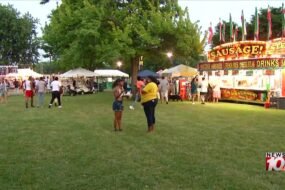
Trees immediately come to mind when visiting the Davis home—the property is wooded on all sides. The western end features a growth of giant bamboo that resembles the Great Wall of China. One would think a person who spends most days cutting trees down would have fewer trees around. Then you notice the gigantic walnut trunk lying by the back fence.
This would be one example of a large collection of specimens large and small brought from one job after another. There are burls, branch unions, milled lumber, and logs for sculpture in the round.
“Trees are living sculptures. Most of what I’ve learned about dendrology has come from dissection for the purpose of craft,” says Jemes Davis. “I began tree climbing when a friend helped us cut some trees down at our Tampa home. I insisted he show me how to do it so I could do the next one. It was awful and terrifying, but I knew I had to become an arborist.
“Tree work can be so many different things. Every tree, location, customer is different, so there is always room for improved craftsmanship. If I can help people to better understand and appreciate the trees they have, trees they could have, or remove trees which have been deemed a risk; I feel as I have provided an essential service.”
I first heard of Jemes Davis as I enjoyed a tour of the Stormwater Studios grounds during an interview with Karen Murphy, an artist, Master Gardener, and entrepreneur who seems to manufacture spare time.
On the back side of the studio’s property a diseased tree stood amongst all the greenery. Murphy pointed it out about the time I noticed the intricate carving along the trunk. The Mother Tree is topped off by two conjoined half discs, both carved from pieces of that same tree, connected to each other and attached to the top.
Jemes, “rhymes with dreams,” Davis works with wood. He spends days cutting trees down, and in his leisure time converting pieces of trees into figments of his imagination. He does it by removing the parts that don’t belong there anymore.
Trees are obviously special to Davis. He feels comfortable within an enclosed stand of timber and wants to make sure trees are as important to the rest of us. He does this by restructuring existing trees, whether diseased or intrusive, and by reimagining existing parts of trees into art.
Davis was born in 1973 in Tulsa, Oklahoma. He knew at an early age he wanted to be a wood carver.
“There was a museum called the Gilcrease Museum we visited at least once a year. It featured wood carvings by a Native American carver. I really wanted to do that.”
The family, like many in Tulsa, didn’t have the resources to invest in expensive art supplies so he primarily was limited to drafting material.
“I wasn’t very good with paints but applied a lot of time working with two dimensional things— but really enjoyed picking up a thing and deviating it. Anything metal, waste products, paper—clay is wonderful; concrete is fascinating. I had a rasp and would find wood chunks.”
This started at age six and continued into adulthood.
“My first chainsaw carving happened when my dad told me to cut a stump down and gave me a really crummy electric chainsaw with plenty of cord. Since then, I’ve become the company safety man for a tree operation, and we don’t teach people how to operate chain saws like that.”
Davis began working in the tree cutting industry to accumulate raw material for art projects. He’s been with Sox and Freeman Tree Expert Company for 23 years now, which seemed to surprise him as he said it.
“It’s been a long string of odd jobs to get to where I am now. I used to love quitting a job just to find something completely different.”
Davis spent most of his early school years in remedial classes and “still can’t do algebra—never could.” As Davis neared graduation, he knew he wasn’t “cut out for higher education.” As he moved from job to job, he realized the only thing he kept getting hired to do was cook, and he didn’t really like cooking.
“I wasn’t fit for a job where consistency was a quality. I didn’t like doing the same thing day after day.”
His parents suggested culinary school, so he attended one in New York. “I liked New York but not cooking.” He kept doing it because it allowed him to travel. After interning in the Big Apple, he met Julia Child and did a stint in Switzerland for a year. Cooking allowed Davis to visit lots of places he might never have experienced.
But Davis got “burned out on cooking” and moved back to Oklahoma and began painting houses. His parents had a small Day Sailer that he could take out on the area lakes. Painting houses wasn’t any more fulfilling than cooking, but sailing recharged his soul.
At some point shortly before the turn of the century, while reading a two year old Cruising World magazine, Davis saw an ad for cooks, deckhands, and dive masters. Blackbeard’s Crew was a weeklong cruise out of Miami into the Bimini Chain in the Bahamas. Cooking three meals a day for around 30 people required three to four hours a day. Davis was free to scuba dive, spearfish, and whatever else he wanted during his spare time. “And free diving. Free diving was a real freedom for me.”
Davis eventually left South Florida for South Carolina due to job opportunities and is working on his third decade in the Midlands. Davis has a job he both likes and is proficient at. “Trees are a valuable resource and add value to our lives just by being there. Seeing the end product of tree removal and accepting the customer’s attitude after he sees the bill isn’t always fulfilling, but constantly being around trees makes that worthwhile.”
His dream of building a woodworking shop has been accomplished and his artistic skills are obvious to anyone walking up to the porch or visiting places like Stormwater Studios. And he owes it all to trees.
Examples of Jemes Davis’s work can be seen at HoFP Galary in Columbia. The website is HoFPGallery.com. He is also on Facebook.














